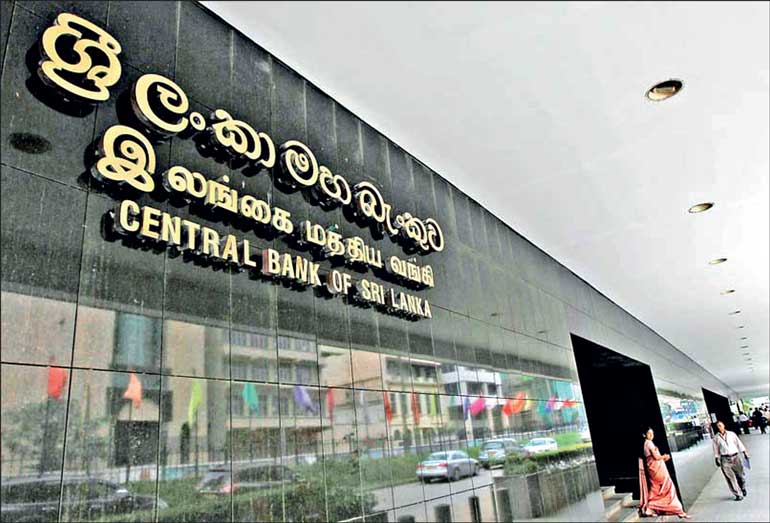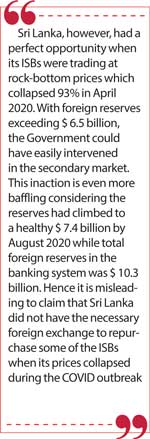Monday Jan 27, 2025
Monday Jan 27, 2025
Wednesday, 11 December 2024 00:22 - - {{hitsCtrl.values.hits}}

CBSL further obfuscates the situation by maintaining an air of secrecy around the current holders of ISBs
 The Central Bank (CBSL) Governor’s sanguine assurances about Sri Lanka’s debt sustainability ring hollow in the face of Sri Lanka’s impending foreign exchange obligations. While the recently signed International Sovereign Bond (ISB) restructuring agreement is touted as a panacea, the reality paints a far grimmer picture. CBSL Governor’s nonchalant dismissal of a potential balance of payments crisis in the new year reminds of Pied Piper that led the rats of Hamelin to their grave while in a hallucinated trance.
The Central Bank (CBSL) Governor’s sanguine assurances about Sri Lanka’s debt sustainability ring hollow in the face of Sri Lanka’s impending foreign exchange obligations. While the recently signed International Sovereign Bond (ISB) restructuring agreement is touted as a panacea, the reality paints a far grimmer picture. CBSL Governor’s nonchalant dismissal of a potential balance of payments crisis in the new year reminds of Pied Piper that led the rats of Hamelin to their grave while in a hallucinated trance.
The Governor’s stale tune shuts our eyes to the impending debt repayments, coupled with the expected surge in personal vehicle imports and the ever-present threat of oil price shocks. With usable foreign exchange reserves barely exceeding $ 5 billion, the CBSL’s confidence in averting a crisis or severe economic distress marked by a sharply depreciating currency and runaway inflation is extraordinarily unfounded.
The Governor’s confidence crumbles under the weight of impending repayments. Next year alone, Sri Lanka faces a staggering $ 4.3 billion (approximately) in additional foreign exchange expenses – a figure that dwarfs our current usable foreign reserves of $ 5 billion. This includes ballooning debt repayments, expiring currency swaps, and a surge in personal vehicle imports. The following account will further discuss the rationality of the above projections and the opaque and self-serving nature of the ISB restructuring agreement conveniently avoided by the CBSL, the apex institution responsible for maintaining the country’s economic stability.
RBI would demand swap repayment
The lion’s share of these additional expenses stems from the ISB restructuring, which, despite its promises, has saddled Sri Lanka with onerous terms. As we have shown in our previous accounts Sri Lanka will have to finance $ 1.85 billion in additional repayments on restructured foreign debt in 2025 (see https://www.ft.lk/columns/Lifting-import-ban-on-automobiles-Sri-Lanka-sleepwalks-into-disaster/4-769115). The backdating of restructuring agreements to 2024 and the conversion of past due interest into a plain vanilla bond of $ 1.7 billion maturing from 2024 to 2027 have exacerbated the debt burden, leading to a one-off spike in repayments next year.
Compounding the problem is the impending maturity of $ 3.6 billion in currency swap arrangements (CBSL Weekly Economic Indicators November 2024), primarily with the Reserve Bank of India (RBI) and the People’s Bank of China (PBC). The swap facility with RBI should be repaid in full by 2026 (notes 25.5 of the Financial Statements and Operations of CBSL 2023). This means an additional leakage of $ 1 billion has to be accounted for on top of the $ 1.85 billion due on restructured foreign debt next year. With $ 1.5 billion in anticipated personal vehicle imports during the year, circa $ 4.3 billion in additional payments will be pitted against foreign exchange reserves of only $ 5 billion (excluding the PBC swap). While the CBSL may claim that these swaps will be rolled over, signing on to an extraordinarily disadvantageous ISB restructuring hand in hand with the decision to liberalise personal vehicle imports will convince the RBI that Sri Lanka is now perfectly capable of repaying differed swap instalments.
Government allows vultures to profit from default
While the Government trumpets its recent ISB restructuring, a closer look reveals a sweetheart deal for a select few, struck at the expense of the Sri Lankan people. Local entities including commercial banks, represented by the Ceylon Chamber of Commerce whose Chairman Duminda Hulangamuwa is now an advisor to the incumbent President, were allowed to swoop in like financial vultures during the COVID crisis, snapping up Sri Lankan ISBs at fire-sale prices – discounts of up to a staggering 45-50%. This windfall for the privileged few came at a steep price for the nation, further draining our dwindling foreign reserves.
 Meanwhile, the government of Ecuador serves as a stark reminder of what could have been. Faced with a similar debt crisis in 2008, they boldly repurchased their defaulted ISBs at a mere 10% of their original value, a move that significantly reduced their national debt burden. This decisive action prioritised the well-being of the Ecuadorian people over the enrichment of private interests. Subsequently, it repurchased 90% of the total outstanding bonds at a whopping 65% discount. Ecuador under the presidency of Rafael Corea formed a public debt commission which found that some of the country’s debt incurred over the last three decades since default were illegitimate for reasons including unfair gains to private interests, oppressive terms in the bond contracts and that the debt burden was drawing resources away from provisioning basic public goods and services (see Bohoslavsky, J., United Nations and Raffer, K (Eds), 2017, Sovereign Debt Crises. Cambridge University Press).
Meanwhile, the government of Ecuador serves as a stark reminder of what could have been. Faced with a similar debt crisis in 2008, they boldly repurchased their defaulted ISBs at a mere 10% of their original value, a move that significantly reduced their national debt burden. This decisive action prioritised the well-being of the Ecuadorian people over the enrichment of private interests. Subsequently, it repurchased 90% of the total outstanding bonds at a whopping 65% discount. Ecuador under the presidency of Rafael Corea formed a public debt commission which found that some of the country’s debt incurred over the last three decades since default were illegitimate for reasons including unfair gains to private interests, oppressive terms in the bond contracts and that the debt burden was drawing resources away from provisioning basic public goods and services (see Bohoslavsky, J., United Nations and Raffer, K (Eds), 2017, Sovereign Debt Crises. Cambridge University Press).
Former CBSL Governor Dr. Indrajith Coomaraswamay’s claim that Ecuador’s oil wealth facilitated their bond repurchase is a convenient smokescreen that crumbles under scrutiny. Ecuador defaulted precisely because of a lack of foreign exchange, yet their collapsed bond prices allowed them to buy back the debt at a fraction of the cost.
Sri Lanka, however, had a perfect opportunity when its ISBs were trading at rock-bottom prices which collapsed 93% in April 2020. With foreign reserves exceeding $ 6.5 billion, the Government could have easily intervened in the secondary market. This inaction is even more baffling considering the reserves had climbed to a healthy $ 7.4 billion by August 2020 while total foreign reserves in the banking system was $ 10.3 billion (see CBSL External Sector Review August 2020). Hence it is misleading to claim that Sri Lanka did not have the necessary foreign exchange to repurchase some of the ISBs when its prices collapsed during the COVID outbreak.
Instead, the Government chose to stand idly by as valuable foreign exchange reserves dwindled, leaving the Sri Lankan people on the hook for a far more expensive restructuring deal. The current 14.9% “haircut” on the ISBs pales in comparison to the 40-45% discount investors were willing to accept on the secondary market. Under a market-driven buyback, Sri Lanka’s total debt burden (including interest payments) could have been slashed to a mere $ nine billion, compared to the staggering $ 18.3 billion under the current restructuring agreement over 15 years.
Who owns Sri Lanka’s ISBs?
CBSL further obfuscates the situation by maintaining an air of secrecy around the current holders of ISBs. Were these new acquirers, also beneficiaries of the fire sale? If so, the Government’s proclaimed “debt relief” is a cynical farce – a burden shifted onto the original investors (who already suffered significant losses) and the Sri Lankan public, who will bear the ultimate cost for years to come, while the vultures who snatched up the bonds in the secondary market reap the rewards.
In essence, if a substantial portion of the original ISB investors sold their holdings at drastically reduced prices in the secondary market, it implies they were willing to accept a deeper haircut of 40-45% compared to the meagre 14.9% Sri Lanka secured through debt restructuring. This paltry relief will evaporate within two years as high-interest payments resume post-2028. Consequently, the relief that the original investors were prepared to extend to Sri Lanka has been usurped and amplified through the high-interest rates and low haircuts embedded in the restructuring deal, benefiting these financial vultures, including local entities such as commercial banks and individuals who acquired bonds under duress from the CBSL.
As the storm clouds of vulture debt repayments, maturing currency swaps and surging imports gather, Government’s ability to balance a house of cards on turbulent waters remains uncertain.